|
I keep this file handy, as the subject comes up often on the forums.
The
Service Manual procedure is OK, but here's what many of us do, which
makes the job quite a bit easier.
Pad replacement is really very simple, and once you do it, you'll
kick yourself for paying to have it done in the past.
(Click the photos for higher detail)
FRONT PADS
1:
Remove the Caliper
First loosen but do not remove the two small
pad retaining pins, with a 1/4" 12 point box wrench or thin
walled socket. Then remove the two 10mm bolts that secure the
caliper to the fork boss.
|
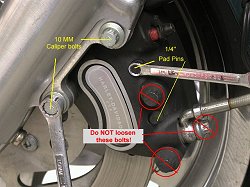 |
2: Slide the caliper down
the rotor
With the caliper bolts removed, (and brake
line still attached), simply slide the caliper down the rotor
until it will clear the fender. If your brake line doesn't have
enough slack to allow fender clearance, it may be necessary to
unbolt the brake line junction from beneath the triple tree, or
you may be able to tape the edge of the fender and flex the
fender in just enough to let it clear. It also helps to rock the
caliper outward and inward to fully seat the pistons, allowing
you some lean room for removal.
|
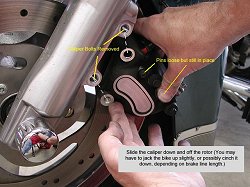 |
|
3: Spread the pads
New pads are going to be too thick for reinstallation of the
caliper, so before you remove the old ones, pry them as far
apart as they will go by inserting your wrench between them and
slowly but firmly twisting and prying at several different
points until both pads are fully seated against the caliper
walls. Now you can finish pulling the pins out
and drop the pads out.
|
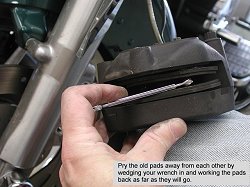
|
4: Lubricate the new pads
Brake pad lubricant is widely available and
should be used to lightly lube the rear surface of the new pads
before reassembly.
|
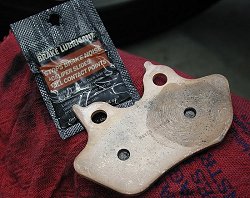
|
| 5: Pads,
pins and pistons
Lubricate both piston contact
areas of the new pad's backing surface, and also lube the
retaining pin. Use some spray on brake parts cleaner to
thoroughly clean the caliper area behind the pads and around the
now exposed pistons. |
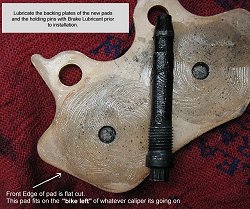 |
Pad Orientation.
Each pad has two different shaped ends. The
flat end goes to the front of the bike and the more curved end
goes to the rear. In both photos above, the front edge of the
pad is on the left (see the arrow note)
|
REAR BRAKE PADS - Since the rear caliper cannot be removed
from its mount without first removing the wheel, we'll leave the rear
caliper in place and just slip the pads out individually. This is a bit
harder to do because of limited access around the caliper, but is still
easier than pulling the rear wheel.
You'll need the same 1/4" 12 point box wrench or thin walled socket
to unscrew the caliper pins (the two smallest heads on the caliper and
they are slightly recessed into the caliper). The pins have a notch on
the other end, so once they're loose they still require a little tug to
get them out of the caliper. If they are badly worn the pins can be
replaced, but at 42K I haven't had to replace mine. The HD dealer has
some caliper lube (comes in a foil packet) or get it at any auto supply
store. Lube the pins lightly with it when you replace them.
- Remove the right saddlebag
- Loosen both caliper pins (do not remove)
- Pull caliper pins just enough to free the inside pad (but not all the
way out)
- Inner pad will now slide out. slide the pad about half way out, then
pry the bottom end slowly and firmly outward (toward the left side of
the bike). This will push the piston deep into its caliper bore, to
allow the new thicker pad to be slipped into place. (if fluid has been
added to the system at all since those original pads were put in, you
may have to remove the cap on the master cylinder to allow fluid to
backtrack, but watch for overflowing brake fluid leaking on the paint!
- Replace with new pad (be sure you have the correct pad, in the correct
orientation) ... they're different. The caliper has an internal
anti-chatter spring that offers a bit of resistance to getting the pin
all the way up, so you have to put a little ooomph behind it to get the
holes to line up.
- Push the caliper pins back through so they hold the inner pad in
place, and apply the brake. This will seat the inner pads to the rotor
again.
- Now pull the pins all the way out to free up the outside pad. The
inside pad will stick to the rotor and stay in place and it'll be easy
to get the pins back in later. If it slips out again, slide one of the
pins in after the outer pad drops, so it will hold the inner pad in
place momentarily.
- Slide the outer pad about half way down, as you did with the inner
pad, and pull the bottom toward you to push the outer piston into its
bore, then you can slide the new pin into place (after removing that
temporary pin) and push the two pins through the caliper and both pads,
and finally tightening them with the 1/4" wrench.
If you can't get the new pads to go into place, you may need to use a
piece of wood or a leather covered screwdriver to reach in and force
those pistons further into their bores.
Apply the brake several times hard. This will seat the pads to the rotor
again.
NOTE: Each pad has two different shaped ends. The flat end goes to the
front of the bike and the more curved end goes to the rear.
All this sounds a bit intimidating, but once you've done it once, you
can almost do it in your sleep.
It's a pretty good idea whenever changing pads to:
1.) Use some 400 or finer grit wet sanding paper to lightly scratch the
glazed surface of the rotor. Do this by sanding inward and outward
toward the axel, NOT in a circle around the rotor.
2.) Use a light wiping of brake grease on the back (metal) side of the
new pads, so they will get along with the pistons better.
Now, if you have floating rotors, the rivets in the rotor may prevent
you from getting the new pads into place. If you can't slide them in
place, it may be necessary to remove the rear wheel to finish the job.
However, depending on how closely the rivets are spaced, you may be able
to rotate the wheel enough to clear the pads.
|





